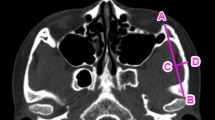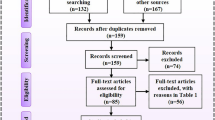Abstract
Background
Various surgical methods have been developed and used to reduce prominent malar bones. The most common reduction malarplasty methods are resection of the bone strip of the malar bone with L-osteotomy or I-osteotomy, followed by setback and fixation. However, these methods could be associated with complications due to the bone strip resection. The present article introduces an effective and safe method that reduces the zygoma without resection of a malar bone strip.
Methods
Through preauricular and intraoral incisions, we performed the current L-osteotomy without resection of the malar bone strip using a reciprocating saw. We created back space for zygoma setback by removing the posterior wall of the maxillary sinus, which acted as a bony interference. We were able to set the lateral segment of the zygoma back about 3–5 mm. We fixed the zygomatic arch with wire and the zygomatic body with a prebent plate and screw. Thereafter, we performed rasping of the anterior part of the zygoma to achieve sufficient reduction. After performing our reduction malarplasty for 139 patients, clinical outcomes were evaluated.
Results
Most patients responded to the satisfaction survey as excellent and good. There were no major complications 6 months postoperatively.
Conclusions
The key of our method of reduction malarplasty is to create posterior space without resecting the malar body strip, which results in an effective setback. This method enables surgeons to effectively maintain the zygoma body, which leads to high satisfaction rates and fewer complications. Therefore, this study proved the safety and effectiveness of our method of reduction malarplasty.
Level of Evidence IV
This journal requires that authors assign a level of evidence to each article. For a full description of these Evidence-Based Medicine ratings, please refer to the Table of Contents or the online Instructions to Authors www.springer.com/00266.









Similar content being viewed by others
References
Onizuka T, Watanabe K, Takasu K, Keyama A (1983) Reduction malar plasty. Aesthet Plast Surg 7(2):121–125
Baek SM, Chung YD, Kim SS (1991) Reduction malarplasty. Plast Reconstr Surg 88(1):53–61
Satoh K, Watanabe K (1993) Correction of prominent zygomata by tripod osteotomy of the malar bone. Ann Plast Surg 31(5):462–466
Sumiya N, Kondo S, Ito Y, Ozumi K, Otani K, Wako M (1997) Reduction malarplasty. Plast Reconstr Surg 100(2):461–467
Lee JG, Park YW (2003) Intraoral approach for reduction malarplasty: a simple method. Plast Reconstr Surg 111(1):453–460
Kim YH, Seul JH (2000) Reduction malarplasty through an intraoral incision: a new method. Plast Reconstr Surg 106(7):1514–1519
Lee KC, Ha SU, Park JM, Kim SK, Park SH, Kim JH (2006) Reduction malarplasty by 3-mm percutaneous osteotomy. Aesthet Plast Surg 30(3):333–341
Baek SMHJ, Baek RM, Oh KS (1997) 10-year experience on reduction malarplasty. J Korean Soc Plast Reconstr Surg 24(6):1478–1487
Nagasao T, Nakanishi Y, Shimizu Y et al (2011) An anatomical study on the position of the summit of the zygoma: theoretical bases for reduction malarplasty. Plast Reconstr Surg 128(5):1127–1138
Hinderer UT (1975) Malar implants for improvement of the facial appearance. Plast Reconstr Surg 56(2):157–165
Wang T, Gui L, Tang X et al (2009) Reduction malarplasty with a new L-shaped osteotomy through an intraoral approach: retrospective study of 418 cases. Plast Reconstr Surg 124(4):1245–1253
Nakanishi Y, Nagasao T, Shimizu Y, Miyamoto J, Kishi K, Fukuta K (2012) The boomerang osteotomy—a new method of reduction malarplasty. J Plast Reconstr Aesthet Surg 65(5):e111–e120
Kook MS, Jung S, Park HJ, Ryu SY, Oh HK (2012) Reduction malarplasty using modified L-shaped osteotomy. J Oral Maxillofac Surg 70(1):e87–e91
Jin H (2011) Reduction malarplasty using an L-shaped osteotomy through intraoral and sideburns incisions. Aesthet Plast Surg 35(2):242–244
Lee YH, Lee SW (2009) Zygomatic nonunion after reduction malarplasty. J Craniofac Surg 20(3):849–852
Yoonho Lee JN (2004) Correction of nonunion of zygoma body after aesthetic reduction malarplasty. J Korean Soc Plast Reconstr Surg 31(3):331–336
Author information
Authors and Affiliations
Corresponding author
Ethics declarations
Conflict of interest
The authors have no conflict of interest to disclose.
Rights and permissions
About this article
Cite this article
Yang, HW., Hong, JJ. & Koo, YT. Reduction Malarplasty that Uses Malar Setback Without Resection of Malar Body Strip. Aesth Plast Surg 41, 910–918 (2017). https://doi.org/10.1007/s00266-017-0879-y
Received:
Accepted:
Published:
Issue Date:
DOI: https://doi.org/10.1007/s00266-017-0879-y




